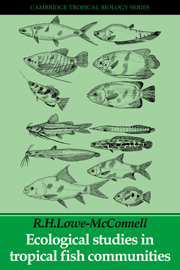Book contents
- Frontmatter
- Contents
- Preface
- Acknowledgements
- PART I INTRODUCTION
- PART II FRESHWATER STUDIES
- 2 The African fish fauna
- 3 Man-made lakes
- 4 Lacustrine fish communities in the Great Lakes of eastern Africa
- 5 Speciation: the African Great Lakes as laboratories of evolution
- 6 The Neotropical fish fauna
- 7 Far Eastern freshwater fish faunas and their distributions
- PART III MARINE FISH STUDIES
- PART IV SYNTHESES
- Appendix: Fish families in tropical waters
- References
- Index
2 - The African fish fauna
Published online by Cambridge University Press: 07 May 2010
- Frontmatter
- Contents
- Preface
- Acknowledgements
- PART I INTRODUCTION
- PART II FRESHWATER STUDIES
- 2 The African fish fauna
- 3 Man-made lakes
- 4 Lacustrine fish communities in the Great Lakes of eastern Africa
- 5 Speciation: the African Great Lakes as laboratories of evolution
- 6 The Neotropical fish fauna
- 7 Far Eastern freshwater fish faunas and their distributions
- PART III MARINE FISH STUDIES
- PART IV SYNTHESES
- Appendix: Fish families in tropical waters
- References
- Index
Summary
Faunal composition
Africa has over 2000 known species of indigenous freshwater fishes. Table 2.1 lists the families they represent, giving approximate numbers of species, although these are only provisional because in some families, especially the Cichlidae, many new species have yet to be described. The table also shows whether families are endemic to Africa, or also found in the Neotropical or Asian tropics or in marine communities. Table 2.2 compares numbers of all species and of cichlids in the main river systems and their associated lakes. Examples of African fishes are shown in Fig. 2.1.
The most striking feature of the African freshwater fish fauna is the high degree of endemism. Eighteen of the families are endemic to Africa and this endemism at family level occurs amongst the less–advanced (pre–Acanthopterygian) fishes: lungfish Protopteridae, brachiopterygian Polypteridae, clupeomorph Denticipitidae and Congothrissidae, osteoglossomorph Pantodontidae, Mormyridae and Gymnarchidae, anotophysan Kneriidae (now taken to include Cromeriidae and Grasseichthyidae (Greenwood, 1975; Nelson, 1984)) and Phractolaemidae, and otophysan characiform Hepsetidae, Distichodontidae, Citharinidae, siluriform Amphiliidae, Mochokidae and Malapteruridae, and cyprinodontiform Aplocheilidae. At generic level almost all genera are endemic to Africa, with the exception of some euryhaline fishes of marine origin and seven genera shared with the Oriental region, viz. the cyprinid Barbus, Garra, Labeo, Raiamasand loach Neomacheilus, the catfish Clarias, also Channa.
- Type
- Chapter
- Information
- Ecological Studies in Tropical Fish Communities , pp. 27 - 62Publisher: Cambridge University PressPrint publication year: 1987

